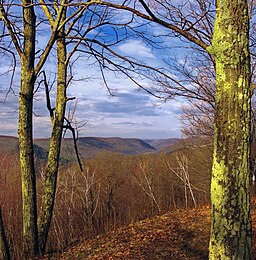Tioga State Forest
| Tioga State Forest | |
| Pennsylvania State Forest | |
|
Babb Creek Canyon, Tioga County, as seen from the Mid State Trail at Gillespie Point.
|
|
| Named for: Tioga River | |
| Country | United States |
|---|---|
| State | Pennsylvania |
| Counties | Bradford, Lycoming, Tioga |
| Elevation | 2,119 ft (645.9 m) |
| Coordinates | 41°46′37″N 77°30′50″W / 41.77694°N 77.51389°WCoordinates: 41°46′37″N 77°30′50″W / 41.77694°N 77.51389°W |
| Area | 160,000 acres (64,750 ha) |
| Founded | 1900 |
| Management | Pennsylvania Department of Conservation and Natural Resources |
| IUCN category | Managed Resource Protected Area (IUCN VI) |
|
Location of Tioga State Forest in Pennsylvania
|
|
| Website: Tioga State Forest | |
Tioga State Forest is a Pennsylvania State Forest in District #16, in the Allegheny Plateau region within Tioga County, Pennsylvania.
The main offices are located in Wellsboro in Tioga County, Pennsylvania in the United States.
The state forest was named for the Tioga tribe of the Seneca, a Native American people, whose homeland was in the region. The Seneca language word "Tioga" means 'the meeting of two rivers' in English.
Prior to the July 1, 2005 realignment of Pennsylvania State Forest Districts, Tioga State Forest included almost all state forest lands in Tioga County and Bradford County, and encompassed 160,000 acres (64,750 ha). After realignment, the state forest tracts in Bradford County became part of the new Loyalsock State Forest.
Tioga State Forest was formed as a direct result of the depletion of the forests of Pennsylvania that took place during the mid-to-late 19th century. Conservationists like Dr. Joseph Rothrock became concerned that the forests would not regrow if they were not managed properly. Lumber and iron companies harvested the old-growth forests, clearcutting the forests and leaving behind nothing but dried tree tops and rotting stumps. The sparks of passing steam locomotives ignited wildfires that prevented the formation of second growth forests. The conservationists feared that the forest would never regrow if there was not a change in the philosophy of forest management. They called for the state to purchase land from the lumber and iron companies and the lumber and iron companies were more than willing to sell their land since that had depleted the natural resources of the forests. The changes began to take place in 1895 when Dr. Rothrock was appointed the first commissioner of the Pennsylvania Department of Forests and Waters, the forerunner of today's Pennsylvania Department of Conservation and Natural Resources. The Pennsylvania General Assembly passed a piece of legislation in 1897 that authorized the purchase of "unseated lands for forest reservations." This was the beginning of the State Forest system.
...
Wikipedia


